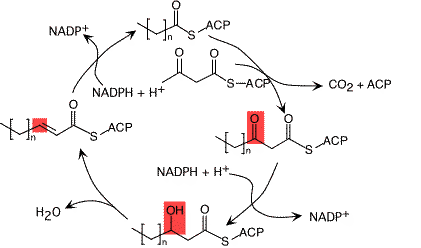Elongation Cycle
1. Condensation of malonyl-CoA with acetoacetyl-ACP chain (+2C)
2. Use two NADPH to reduce the B-ketone and generate acyl-ACP molecule (2C+)
3. The acyl-ACP continues in elongation till the wanted chain length is achieved.
4. The fatty acid is transfered from the acyl-ACP to sn-glycerol-3-phosphate to make phosphatidic acid.
5. Then, we add the hydrophilic part to it.
NOTE_ the glycerol backgone of lipid is from dihydroxyacetone phosphate, which is reduced to sn-glycerol-3-phosphate with NADH

www.bact.wisc.edu/microtextbook/Metabolism/lipidSyn.html
